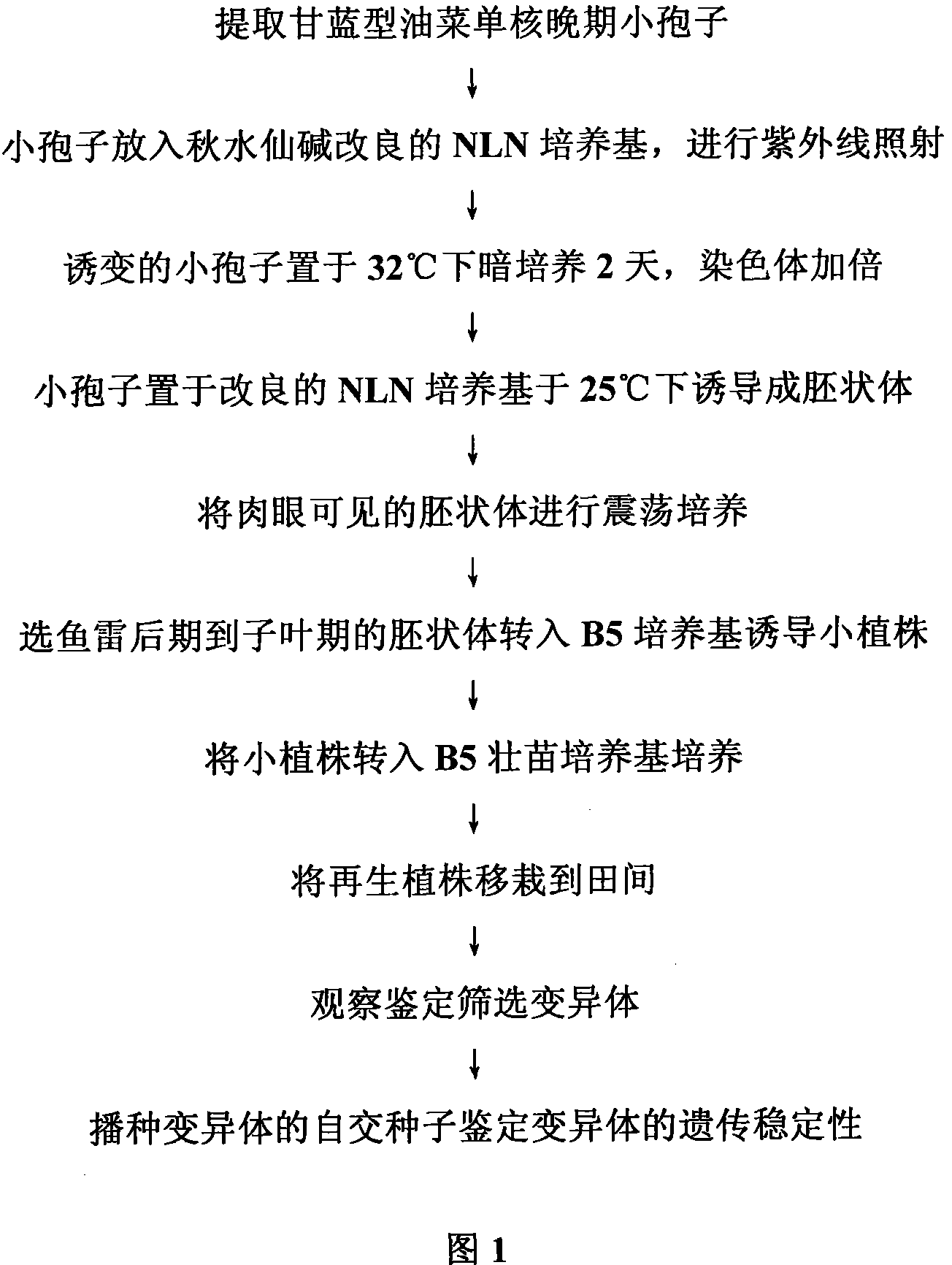Method for inducing wild cabbage type cole in vitro microspores and screening mutant
A technology of brassica napus and microspores, which is applied in the field of plant cell engineering, can solve the problem of the theory and method research of in vitro mutagenesis of microspores without ultraviolet radiation, the correlation between irradiation time and dose rate and variation, and the distance of in vitro microspores. And the radiation time is different, to achieve the effect of convenient use of radiation source, saving time and cost, safety and security of operators
- Summary
- Abstract
- Description
- Claims
- Application Information
AI Technical Summary
Problems solved by technology
Method used
Image
Examples
Embodiment 1
[0034] Isolation and In Vitro Mutagenesis of Microspores of Brassica napus
[0035] During the flowering stage of rapeseed, the main plants of Brassica napus varieties Zhongyou 821, Huashuang 5, Huashuang 2, Huahuang 1, and Huayou 8 (the above-mentioned varieties are publicly promoted in China) were taken from the test field. Take the stem or branch inflorescence to the laboratory, select the flower buds whose microspores have developed to the uninucleate late stage, and then soak the flower buds in 70% ethanol aqueous solution for 0.5-1 minute, and then soak them in 0.1% mercury liter aqueous solution for 8-10 minutes. Minutes (the following operations are all performed on a clean bench), and then rinsed with sterile water 3 times. Put the sterilized flower buds on the surface into a sterile test tube (the following utensils are all sterilized), crush them with a glass rod, and then add the microspore extract containing 13% sucrose to the test tube (according to the number of...
Embodiment 2
[0041] Chromosome doubling and embryoid body induction of microspores of Brassica napus
[0042] The rapeseed microspores suspended in colchicine NLN medium and irradiated with ultraviolet rays were cultured in the dark at 32°C for 2 days to perform chromosome doubling. Afterwards, the colchicine medium containing the microspores in the petri dish was transferred into a centrifuge tube with a pipette and centrifuged (500 rpm, 3 minutes) on the ultra-clean workbench to precipitate the microspores. Then use a straw to suck off the colchicine medium, add 6ml of colchicine-free modified NLN medium into a centrifuge tube, suspend the microspores, then pour them into a 7.5ml diameter petri dish, seal the lid with paraffin film, and put Culture in a culture room at about 25°C in the dark to induce embryoid bodies.
Embodiment 3
[0044] Induction of Regenerated Plants of Brassica napus
[0045] When the microspores cultured in the dark at about 25° C. produce small embryoid bodies visible to the naked eye (usually 10 days after the microspores are isolated), put the petri dish into a shaker for shaking culture (50 rpm). When the embryoid develops from the late torpedo stage to the early stage of the cotyledon, stop the shaking culture, transfer it to the B5 solid medium supplemented with 2% sucrose, and cultivate it in a culture room at about 25°C (12 hours of light per day, light intensity 3000LUX) , to induce embryoid body germination. When the embryoid bodies produced plantlets with leaves and stems or deformed plantlets, the roots of these plantlets were excised, and then transferred to B5 strong seedling medium supplemented with 0.12 mg / L paclobutrazol to cultivate robust regeneration plants.
[0046]The preparation of the above-mentioned B5 strong seedling medium: adopt the original B5 medium co...
PUM
 Login to View More
Login to View More Abstract
Description
Claims
Application Information
 Login to View More
Login to View More - R&D
- Intellectual Property
- Life Sciences
- Materials
- Tech Scout
- Unparalleled Data Quality
- Higher Quality Content
- 60% Fewer Hallucinations
Browse by: Latest US Patents, China's latest patents, Technical Efficacy Thesaurus, Application Domain, Technology Topic, Popular Technical Reports.
© 2025 PatSnap. All rights reserved.Legal|Privacy policy|Modern Slavery Act Transparency Statement|Sitemap|About US| Contact US: help@patsnap.com



